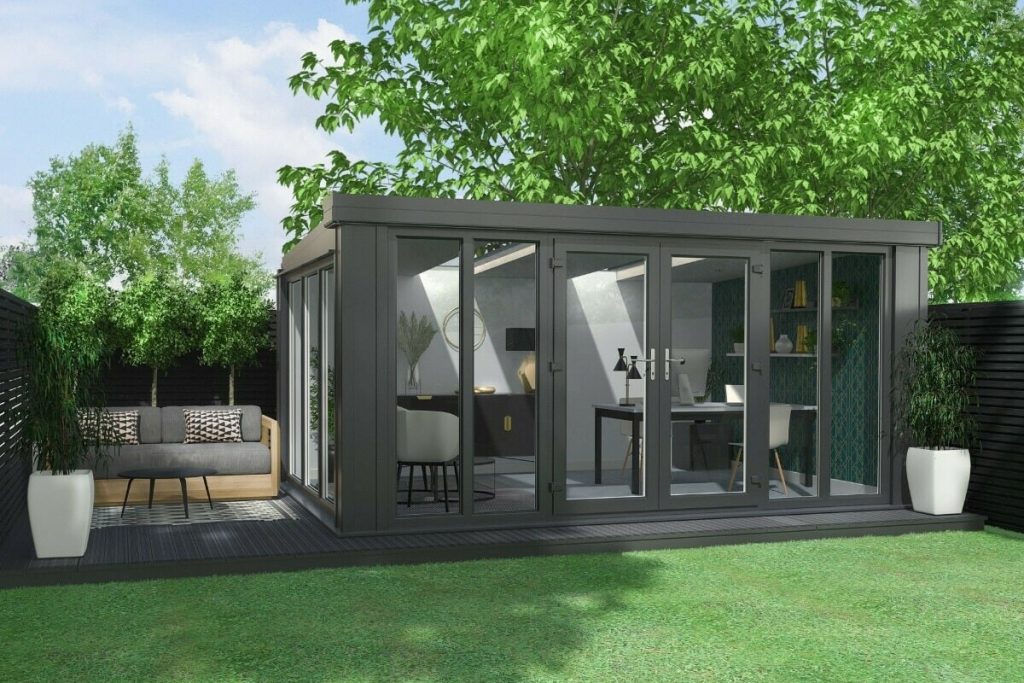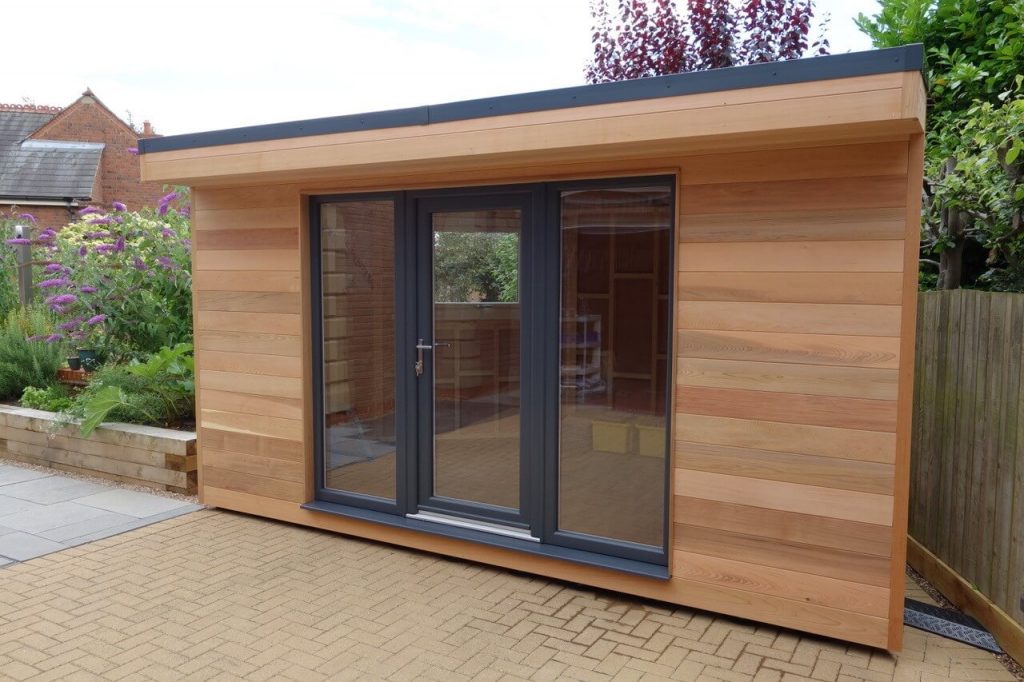Our last day is Friday 19th December for the Christmas break, and we will be back in the office on 5th January 2026!
Do You Need Planning Permission for Garden Room with Toilet?

Key Highlights
Here are the key takeaways you need to know about building a garden room with a toilet:
- Most garden rooms fall under permitted development, meaning they don’t need a full planning application.
- However, adding a toilet often changes this, as it can be seen as creating self-contained accommodation.
- Your project will likely need to comply with building regulations, especially for plumbing and electrical work.
- Strict rules on size, height, and placement apply if you want to stay within permitted development rights.
- You must not build on more than 50% of your total garden area.
- Always check with your local council, as rules for garden room planning permission can vary.
Introduction
Are you dreaming of a new garden room complete with the convenience of a toilet? It’s a fantastic way to add functional space to your property, but it also introduces important questions about regulations. The main one is: do you need garden room planning permission? While many outdoor structures fall under permitted development, adding plumbing complicates things. This guide will walk you through the essential rules for planning permission and building regulations to help you get your project right from the start.
Understanding Planning Permission for Garden Rooms in the UK
Navigating the rules for garden buildings can feel complex, but it’s manageable once you understand the basics. In most cases, you won’t need to file a planning application for a standard garden room because it’s considered permitted development. This is essentially a government-granted permission that allows for certain home improvements without a lengthy approval process.
However, these development rights come with strict conditions. When you add features like a toilet, the planning rules can change significantly, and you may need to seek approval from your local planning authority. We’ll explore what a garden room is legally and why a toilet makes a difference.
What Is a Garden Room and How Is It Defined Legally?
Legally, a garden room is classified as an “outbuilding.” This term covers structures like sheds, summerhouses, and garden offices that are built within the boundary of your property but are not attached to the original house. For your project to be considered an outbuilding under permitted development, it must be used for purposes “incidental” to the enjoyment of the main home. This means its function should be a minor accompaniment to the primary dwelling.
Do I need planning permission to build a garden room in the UK? Generally, no, provided it meets the specific criteria for permitted development. These rules define garden buildings as single-storey structures that adhere to size and height limits. The key is that the building’s use doesn’t create separate living quarters.
Understanding this legal definition is the first step. If your building stays within these guidelines, you can often proceed without a formal planning application. However, deviating from these uses or specifications will require you to seek official permission.
Why Adding a Toilet Changes Planning Permission Considerations
The moment you decide to install a toilet, the planning permission landscape shifts. Why? Because adding bathroom facilities can change the legal classification of your garden room. A structure with a toilet is no longer seen as purely “incidental.” Instead, it could be interpreted as self-contained accommodation, which is explicitly excluded from permitted development rights. This is a critical distinction that many homeowners overlook.
Can I add plumbing and electricity to my garden room without affecting planning permission? While adding electricity for lighting or a computer is usually fine, plumbing for a toilet is another story. The inclusion of bathroom facilities suggests the building could be used for living or sleeping, even if that’s not your primary intention.
This change in use almost always means you will need to submit a full planning application for your garden room. Your local council will want to assess the impact of what they now consider a potentially habitable space, moving it beyond the scope of permitted development.
Permitted Development Rights and Garden Rooms

Permitted development rights are a homeowner’s best friend for many projects. They are a national grant of planning permission that allows you to carry out certain building works without submitting a formal application. This saves you time and money. Garden rooms are a prime example of a project that can often be completed under these rights.
However, these rights are not unlimited. To qualify, your project must follow a strict set of development guidelines. These permitted development rules cover everything from the building’s height to its location on your property. Let’s look at the specific criteria you’ll need to meet.
Key Criteria for Permitted Development
If you want to build your garden room under permitted development, you must follow the permitted development guidelines precisely. Failing to meet even one of these conditions could mean you need to apply for planning permission. So, what are the main planning permission requirements for a garden room built this way?
First, the use of the garden room must be incidental to the main house and not for living or sleeping accommodation. Beyond its use, there are several structural and placement rules you must adhere to. The key criteria include:
- The garden room is not built on land forward of a wall forming the principal elevation of your home.
- It must be single-storey with specific height limits.
- The total area of all outbuildings, including the new one, must not exceed 50% of the land around your “original house.”
- The structure cannot have a veranda, balcony, or raised platform.
Meeting these conditions is essential to avoid the need for a full planning application.
Limitations on Size, Height, and Placement
The permitted development rules are very specific about the dimensions of your garden room. Adhering to these limitations on size, height, and placement is crucial. Are there height restrictions for garden rooms for planning permission? Yes, and they are quite strict. The maximum height depends on the roof type and its proximity to your property’s boundary.
For placement, the building cannot be located forward of the principal elevation of your house. Furthermore, the total area of land covered by all outbuildings must not be more than half of the garden space around your original home. The term “original house” refers to how it stood on July 1, 1948, or when it was first built.
Here is a quick summary of the height and placement rules:
| Feature | Permitted Development Limit |
|---|---|
| Placement | Not in front of the main house. |
| Maximum Eaves Height | 2.5 meters from ground level. |
| Maximum Overall Height | 2.5 meters if within 2 meters of a boundary. |
| Max Height (Other Cases) | 4 meters for a dual-pitched roof, 3 meters for any other roof. |
| Garden Coverage | All outbuildings must not cover over 50% of the garden area. |
Adding Toilets and Plumbing: Rules and Implications
When you decide to add a toilet to your garden room, you introduce a new layer of regulations. This goes beyond garden room planning permission and into the realm of building regulations. The toilet installation itself must meet specific plumbing regulations to ensure it’s safe, sanitary, and correctly connected to your property’s drainage system.
This addition almost certainly means you will need building regulations approval, even if the structure itself is small. The following sections will explain the key plumbing and drainage rules and how having a bathroom impacts your overall planning requirements.
Plumbing and Drainage Regulations Explained
Adding a toilet requires careful attention to plumbing and drainage regulations. You can’t simply connect a pipe and hope for the best. Your new toilet will need a fresh water supply and, more importantly, a way to remove waste. This typically involves connecting to your home’s main soil pipe, which carries waste to the sewer. If a direct gravity-fed connection isn’t possible, you may need a macerator pump to move the waste.
Any new plumbing work must comply with building regulations to ensure public health and safety. Furthermore, if a pump is needed for drainage, the electrical work to power it must comply with Part P of the building regulations. Key considerations include:
- Connecting to a fresh water supply.
- Ensuring waste water can connect to an existing drain.
- Potentially fitting a macerator pump for waste.
- Ensuring all electrical work for pumps is certified under Part P.
Failing to meet these standards can lead to serious issues, so professional installation is essential.
Impact of Bathroom Facilities on Planning Requirements
The presence of bathroom facilities is one of the biggest factors that can push a garden room project out of permitted development. As soon as you add a toilet or shower, the building is no longer considered purely “incidental.” Instead, it is viewed as having the potential for self-contained living or sleeping accommodation. This is a red flag for planning authorities.
What types of garden buildings typically require planning permission? Any building intended for sleeping, such as a guest annexe, will always require a planning application. Adding a toilet puts your garden room in a similar category because it provides amenities for habitation.
Therefore, you should assume that a garden room with a toilet will require a full planning application. You will need to submit detailed plans to your local council for approval before any work can begin, as it falls outside the scope of permitted development.
Building Regulations You Need to Know
It’s important to understand that building regulations are separate from planning permission. Planning permission concerns whether you’re allowed to build the structure, while building regulations dictate how it must be built. These rules ensure the new building is safe, structurally sound, and energy-efficient.
Even if you don’t need planning permission, you might still need building regulations approval. This is especially true for a garden room with a toilet, as it involves complex electrical and plumbing work. Let’s examine when these regulations apply and what they cover.
When Do Building Regulations Apply to Garden Rooms with Toilets?
So, when do building regulations apply to garden rooms with toilets? The rules are based on size and use. Generally, a detached building with an internal floor area of less than 15 square meters is exempt, as long as it contains no sleeping accommodation. For buildings between 15 and 30 square meters, they are exempt if they are at least one meter from any boundary or constructed of non-combustible materials.
However, the inclusion of a toilet changes everything. The installation of plumbing and drainage systems in a new building automatically brings it under the scope of building regulations, regardless of its size. The toilet installation must meet specific sanitary standards.
Therefore, if your garden room includes a toilet, you should expect to seek building regulations approval. This process ensures that the plumbing, drainage, and structure are all compliant and safe.
Electrical and Structural Safety Considerations
Safety is non-negotiable, and building regulations ensure your garden room is structurally sound and electrically safe. Can I add plumbing and electricity to my garden room without affecting planning permission? As we’ve seen, plumbing for a toilet complicates planning, and both plumbing and electricity require adherence to building regulations. All electrical work must comply with Part P of the Building Regulations.
This means any new electrical work, such as connecting the garden room to the mains supply, must be carried out by a qualified electrician. They will issue an electrical installation certificate to prove it’s safe. Key safety considerations include:
- Structural Integrity (Part A): The building must be strong enough to withstand loads from weather and use.
- Electrical Safety (Part P): Any electrical work must be certified by a registered electrician, often involving the installation of an armoured cable.
- Insulation (Part L): While often exempt for smaller buildings, good insulation qualities of walls improve comfort and efficiency.
- Professional Certification: You must receive an electrical installation certificate for all notifiable work.
Location and Boundary Restrictions
Where you decide to place your garden room is just as important as how you build it. Permitted development rights come with strict location and boundary restrictions that you must follow. These planning rules are in place to protect the privacy of your neighbors and maintain the character of the area.
For example, there are specific limits on how close you can build to your property lines, especially concerning the building’s height. If your property is in a designated area, like a National Park, even stricter rules apply. We’ll now look at these restrictions in more detail.
Distance from Property Boundaries and Neighbor Considerations
One of the most critical permitted development rules relates to the distance from property boundaries. How close can a garden room be to my property boundary without needing planning permission? If your garden room is within two metres of a boundary, its maximum overall height is restricted to 2.5 meters. This rule is designed to prevent your new building from overshadowing or overlooking neighboring properties.
For buildings with an internal floor area between 15 and 30 square meters, they must be positioned at least one meter from any boundary to avoid needing building regulations approval (unless built from non-combustible materials). While not a legal requirement for permitted development, it’s always a good idea to discuss your plans with your neighbors. This simple courtesy can prevent disputes and maintain good relations. Key points include:
- Maximum height of 2.5m if within 2 metres of a boundary.
- No part of the garden room can extend beyond the front wall of your house.
- Informing neighbors is a recommended courtesy.
Impact of Local Authority Variations Across the UK
Does planning permission for garden rooms differ depending on where I live in the UK? Yes, it can. While the national permitted development guidelines provide a baseline, your local council has the final say. Some local planning authorities have special conditions or may have removed permitted development rights in certain areas through what is known as an Article 4 Direction.
This is especially common in designated areas like National Parks, Conservation Areas, Areas of Outstanding Natural Beauty (AONB), and World Heritage Sites. If you live in one of these locations, you will likely need to apply for planning permission for any outbuilding.
Before you start any work, it is crucial to contact your local planning office or check the national Planning Portal. They can confirm whether any local variations apply to your property and guide you on the correct process for your specific circumstances.
Conclusion
In conclusion, navigating the complexities of planning permission for a garden room with a toilet is essential for ensuring a smooth building process. Understanding the legal definitions, permitted development rights, and local regulations can save you time, effort, and potential headaches down the line. By adhering to the necessary guidelines, you can create a functional and compliant garden space that meets your needs. Remember, each situation is unique, so don’t hesitate to consult with local authorities or professionals if you’re unsure. For more personalized guidance, feel free to get in touch and book a free consultation with our experts!
Frequently Asked Questions
What happens if I build a garden room with a toilet without planning permission?
If you build without the necessary planning permission, your local planning authority can issue an enforcement notice. This may require you to submit a retrospective planning application. If that application is denied, you could be forced to remove the building and return the land to its original state.
Can I use my garden room as a home office or guest accommodation with a toilet?
Using your garden room as a personal home office is usually acceptable under permitted development. However, adding a toilet and using it as guest accommodation implies it is self-contained living space. This falls outside permitted development and will require you to obtain full planning permission before you build.
Are there height restrictions for garden rooms with toilets under permitted development?
Yes, strict height restrictions apply. Under permitted development, the maximum height is 2.5 meters if the building is within two meters of a boundary. Otherwise, the overall height can be up to 4 meters for a dual-pitched roof or 3 meters for other roof types.
